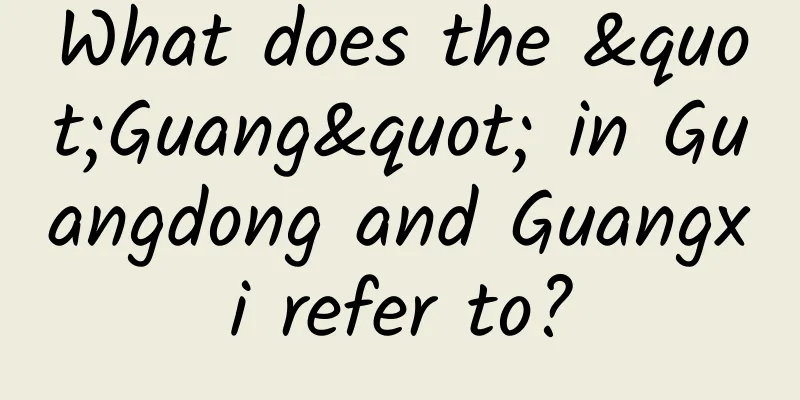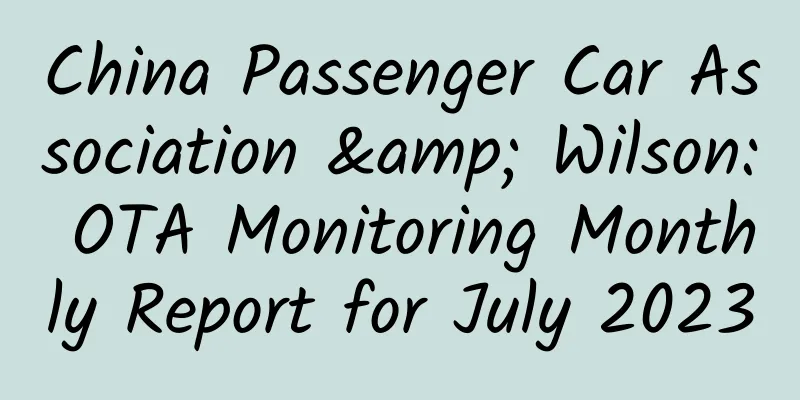What does the "Guang" in Guangdong and Guangxi refer to?

|
We all know that the "He" in Henan and Hebei refers to the Yellow River, and the "Hu" in Hunan and Hubei refers to Dongting Lake. However, there are various opinions about where the "Guang" in Guangdong and Guangxi refers to. Some say it comes from the "Guang" in Huguang Province during the Ming and Qing Dynasties. Guangdong is to the east of Huguang Province, and Guangxi is to the west of Huguang Province. Others say it comes from Guangnan West Road and Guangnan East Road in the Song Dynasty. So where does the "Guang" in "Huguang" and "Guangnan" come from? I don't know if you are dizzy after all the twists and turns. Let's talk about this topic today. Guangzhou, Guangnan, Huguang, Guangdong, Guangxi, all of which have "Guang" in their names, are they the same thing? To understand this question, we need to sort out history. After the Qin Dynasty unified the six kingdoms, it conquered the Baiyue in the south and then established three counties: Guilin, Xiang, and Nanhai. At the end of the Qin Dynasty, the world was in chaos. Zhao Tuo, the prefect of Nanhai, cut off the passage from the Central Plains to Lingnan to establish his own regime, with Panyu as the capital, and established the Nanyue Kingdom. During the reign of Emperor Wu of Han, Nanyue was destroyed and nine counties were set up in Lingnan, including Nanhai, Cangwu, Yulin, Hepu, Jiaozhi, Jiuzhen, Rinnan, Zhuya and Dan'er, which once again brought Lingnan under the rule of the Central Plains dynasty. As Panyu was burned to ruins during the war, Emperor Wu of Han built a new city at the confluence of Lishui and Yushui, and named it Guangxin County, which means "when opening up the land of Guangdong, it is appropriate to spread kindness and trust". Guangxin County was the seat of both Cangwu County and Jiaozhou Prefecture. For more than 300 years thereafter, Guangxin became the capital of Lingnan, with a unique status. At the end of the Eastern Han Dynasty, the country was in chaos, and the seven counties of Jiaozhou were no exception. They became a place of struggle between Liu Biao, the Eastern Han court, and Sun Quan. In the end, Sun Quan's Eastern Wu controlled Jiaozhou. Bu Zhi, the governor of Jiaozhou, divided Jiaozhou into two, setting up Guangzhou (which governs today's Guangdong and Guangxi) out of the four counties of Nanhai, Cangwu, Yulin, and Gaoliang. Because Guangxin was governed by the governor, the word "Guang" in Guangxin was taken as the name of the prefecture, and Guangzhou was named after this. The prefecture was governed by Panyu (today's Guangzhou); the rest was Jiaozhou. At the beginning of the Tang Dynasty, Lingnan was divided into five governorates (also known as the Five Governorates of Lingnan), namely Guangzhou, Guizhou, Rongzhou, Yongzhou and Annan. All five governorates were under the jurisdiction of Guangzhou, and the governor of Guangzhou concurrently served as the governor of the five governorates to govern the five governorates of Lingnan. In 756, Emperor Suzong of Tang promoted the governor of the five governorates to the governor of Lingnan. In 862, Emperor Yizong of Tang divided Lingnan into Lingnan East and Lingnan West. During the Song Dynasty, Emperor Taizong of Song changed the word "dao" into "lu", dividing the country into 15 routes. The Lingnan Road of the Tang Dynasty was restored and renamed Guangnan Road, which was named after the combined name of Guangxin and Lingnan. In 997, Guangnan Road was divided into Guangnan East Road (the seat of government was in Guangzhou) and Guangnan West Road (the seat of government was in Guizhou, now Guilin). The names of Guangdong and Guangxi today are roughly derived from this. In the Yuan Dynasty (1277), Huguang Province was established, and Guangxi belonged to it. Guangdong belonged to Jiangxi Province at that time. In the late Yuan Dynasty (1363), Guangxi Province was established, and in the Ming Dynasty (1369), Guangdong Province was established. From the above historical context, we can see that the "Guang" in Guangzhou, Guangnan, Huguang, Guangdong, and Guangxi all have the same origin, from the same place "Guangxin". Guangxin is the name of an ancient county, located in the area from Wuzhou, Guangxi to Fengkai, Guangdong. According to research, the county seat is in Fengkai County, Zhaoqing City, Guangdong Province. Fengkai County, formed by the merger of Fengchuan County and Kaijian County, is located in the northwest of Guangdong Province, on the upper reaches of the Xijiang River, adjacent to Wuzhou City, Guangxi. The county seat Jiangkou Town is located at the intersection of the Xijiang River and the Hejiang River. Fengkai is the throat of Guangdong leading to Guangxi and southwestern provinces, and is known as the "gateway to Guangdong and Guangxi". The "Fengchuan County Chronicles·General Theory of Cities and Towns" in the Ming Dynasty records that "Jiangkou is the ancient Guangxin administrative area", and there is also a river called Guangxin River in Xinghua Town, Fengkai County. The "Draft of Guangxi General History·Geography" compiled by Meng Qipeng in the Qing Dynasty records: "The Guangxin of the Han Dynasty is today's Fengchuan County. The governor of Jiaozhou governed Guangxin and was in charge of three counties. Today, the three counties are divided into two provinces. The west of Fengchuan is Guangxi, and the east of Fengchuan is Guangdong." It can be seen that the source of the "Guang" in Guangdong and Guangxi is Guangxi, which is now Fengkai, Guangdong. (Statement: This article is from Map Emperor. It is reproduced only for learning and communication, not for commercial purposes. All reproduced articles will indicate the source. If the original author of the article or photo has any objection, please contact us in the background and we will quickly process or delete it. Thank you for your support.) |
<<: The Wentian experimental cabin has been relocated, and here come the hard-core knowledge points!
>>: It turns out that China’s “mother flower” is not the carnation, but this!
Recommend
June stargazing guide: Supermoon and meteor showers add color to the most beautiful Milky Way
Original title: June stargazing guide: "Supe...
Forbes: Chinese Xbox One players will return to the grey market
China lifted its ban on game consoles six months a...
Le Xiaobao: A smart parent-child hardware product with "burden"
In the traditional toy development industry, the ...
[Must-Hide] A Complete App Product Operation and Promotion Plan
1. App operation and promotion positioning APP pr...
Is there a "Liu Genghong girl" injured? Doctors remind...
"Have you worked out with Liu Genghong today...
The Three Kingdoms is not just about wars. The TV version of Legend of the Three Kingdoms is available for trial play.
I believe that anyone who has read Luo Guanzhong&...
Unexplained childhood hepatitis appears in many countries! What exactly is hepatitis?
Mixed Knowledge Specially designed to cure confus...
Jieshou SEO training: What should I do if my website is not included?
In fact, websites that are not indexed are genera...
What kind of job can earn 10,000 yuan a day?
Many people dream of getting rich overnight, marr...
Google is reportedly developing a standalone VR device that can be used without a PC
Google is developing an all-in-one virtual realit...
How to plan an efficient marketing operation plan?
In recent years, mobile Internet has developed ra...
Teacher Qi's "Brick and Mortar Store Douyin Account Traffic Growth Operation Course"
Teacher Qi's "Physical Store Douyin Acco...
Ergun SEO training: What is site group optimization? How to optimize site clusters through black hat means?
When it comes to black hat SEO, it often gives no...
Deconstructing Hua Xiaozhu’s operational strategy!
1. What is Flower Pig ? Hua Xiaozhu is a taxi-hai...









